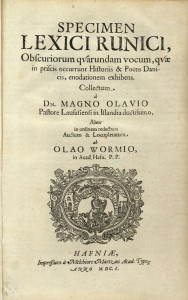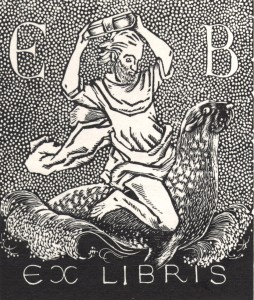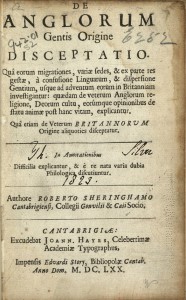
March 7, 2012, by H Cotterill
Reading the Runes
In this guest blog, Judith Jesch, Professor of Viking Studies, highlights items from our Icelandic collections in advance of the forthcoming Fell-Benedikz lecture about runes.
We tend to associate runes and runic inscriptions with the Vikings and the Anglo-Saxons, who used this form of writing before Christianity brought them the Roman alphabet and manuscript culture. But in Scandinavia and Iceland, runes continued to be used well into the medieval and early modern periods. This topic will be explored by Michael Barnes of University College London, in a lecture entitled Twilight of the Runes: Runes and Runic Writing in the post-Reformation era. This public event will be held on Thursday 8 March 2012 in the Senate Chamber, Trent Building, at 6.00pm.
Runes also played their part in the Northern Renaissance, the rediscovery of the Germanic and Celtic vernacular cultures of northern Europe from the late 16th century onwards. It was quite common then for books presenting Old Norse sources to a Latinate audience to be written partially in runes, as in Robert Sheringham’s De Anglorum Gentis Origine Disceptatio (Cambridge, 1670), the first extensive occurrence of Old Norse texts in an English publication.
English scholars like Sheringham built on the efforts of their Scandinavian contemporaries, such as the Icelander Magnús Ólafsson of Laufás, whose Specimen Lexici Runici (Copenhagen, 1650), put together at the request of the great scholar Ole Worm, was the first dictionary of the Old Norse language. In this book the headwords are printed in runic characters, but the vocabulary is not that of any runic inscriptions, but rather the vocabulary of the medieval Icelandic sagas which were just being rediscovered at that time.
This use of the word ‘runic’, to typify anything old and northern, became prevalent in the 18th century, as in Bishop Percy’s influential Five Pieces of Runic Poetry Translated from the Islandic Language(London, 1763), at a time when there was a veritable craze for Old Norse poetry.
These three books reached Nottingham’s Special Collections because of their connections with the people commemorated in the Fell-Benedikz lecture. The Sheringham and the Specimen came from the collection of the late Christine Fell, Professor of Early English Studies, who had a particular research interest in the early modern reception of Viking and Anglo-Saxon cultures. The Percy forms part of the large Benedikz collection, once the library of the Icelandic bibliophile and diplomat Eiríkur Benedikz. This collection was donated to Nottingham by his family, and subsequently augmented by his son Benedikt S. Benedikz, himself a noted scholar of Icelandic studies, and of rare books.
The Benedikz collection can be accessed through the online catalogue and consulted at the King’s Meadow reading room of Manuscripts and Special Collections. Items from these and other Icelandic holdings in the collections can be seen in an online exhibition Ice, Fire and Northern Myths.
Judith Jesch, School of English
No comments yet, fill out a comment to be the first





Leave a Reply